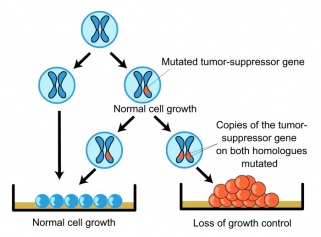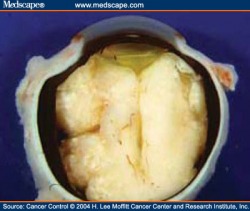This web page was produced as an assignment for Genetics 677, an undergraduate course at UW-Madison
Retinoblastoma and the RB1 gene

Figure 1
Overview
Retinoblastoma is a malignant cancer of the eye that develops in the retina of a growing child, most commonly before the age of 5. The disease manifests itself in cells which have cancer-predisposing mutations in both copies of their RB1 gene, a tumor suppressor gene. Retinoblastoma can be unilateral, affecting only one of the eyes, or bilateral, affecting both. (2)
History
The study of retinoblastoma began in the 1950s and was one the first heritable cancers that was studied in detail Much of what we know today about heritable cancers has come from the study of retinoblastoma. One of the concepts that became well understood from the study of retinoblastoma is the two hit hypothesis.(6)
The two hit hypothesis was developed by Alfred Knudson in 1971. It describes the concept of cancer cause through the loss of tumor suppressor genes. The theory states that two hits are necessary for cancer. One hit must disable each copy of the tumor supressor gene, one on each chromosome. However, if a child inherits a disfunctional copy of the Rb1 gene from a parent, they already have one hit, or only one good copy of the Rb1 gene. This means that threre is only one more hit necessary for the development of retinoblastoma.(6)
It was originally thought that the loss of the two copies of the Rb1 gene was enough for cell cycle control to be lost and for retinoblastoma to develop. This is partially correct, but isn't the whole picture. We now know that in addition to the loss of the two copies of Rb1, oncogenes must be activated as well to achieve a carcenogenic state. (6)
Cause
Retinoblastoma only occurs when both copies of the tumor suppressor gene RB1 are mutated. These mutations prevent the RB1 gene from making a functioning protein, which is necessary in regulating cell growth. Without effective regulatory proteins, retinal cells divide uncontrollably, eventually forming a malignant tumor. (1)
There are two ways which a child can develop Retinoblastoma. Children can inherit one mutated copy of the RB1 gene from their parents, which is referred to as having a germ line mutation. This makes the child more likely to develop the cancer, as there is only one working copy of the RB1 gene to be lost, instead of two. The other way is for both copies to be deactivated due to spontaneous mutations in each copy of the RB1 gene. (3)
Prevalence
Retinoblastoma affects an estimated one child for every 15,000 live births. There is no specific geographical location where Retinoblastoma is known to be more prevalent. As long as the tumor is treated before it extends outside, there is a very low risk of mortality. As the tumor size increases, so does the risk of mortality. Over 95% of children who develop retinoblastoma survive with medical treatment, however in the majority of the cases the child loses vision in the affected eye. Only about 10% of affected children have the necessary family history to warn of the risk to the child.(2)

Fig. 2
Effects
Once both tumor-suppressor genes have been deactivated in a cell, it has the ability to divide uncontrolled. The result of this is the formation of a retinoblastoma, a tumor within the eye. (3)
Goal
The goal of this project is to investigate the genetic cause and proteomic consequences of having Retinoblastoma.
References
1. Raquel H. Barbosa, et al. (2008) Hereditary retinoblastoma transmitted by maternal germline mosaicism. Medical and Pediatric Oncology, 51(5): 598-602 http://www3.interscience.wiley.com/journal/120849349/abstract?CRETRY=1&SRETRY=0
2. Gene Reviews:Retinoblastoma. http://www.ncbi.nlm.nih.gov/bookshelf/br.fcgi?book=gene&part=retinoblastoma
3. Genetics Home Reference. http://ghr.nlm.nih.gov/gene=rb1
4. Figure 1: http://219.221.200.61/ywwy/zbsw(E)/edetail12.htm
5. Figure 2: http://www.medscape.com/content/2004/00/49/13/491384/491384_fig.html
6. Lohmann DR, Gallie BL (2004). "Retinoblastoma: revisiting the model prototype of inherited cancer.". American journal of medical genetics. Part C, Seminars in medical genetics 129 (1): 23–8.
Justin Lengfeld
[email protected]
Genetics 677
Last Update: 5/13/09
